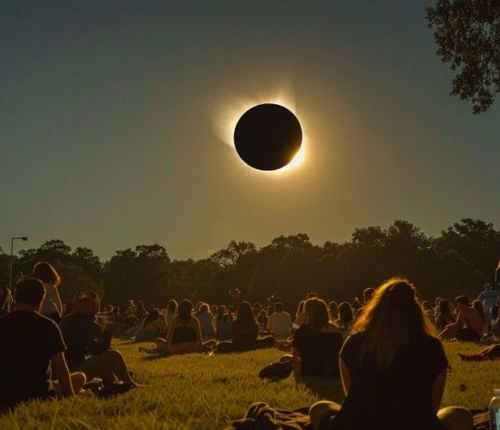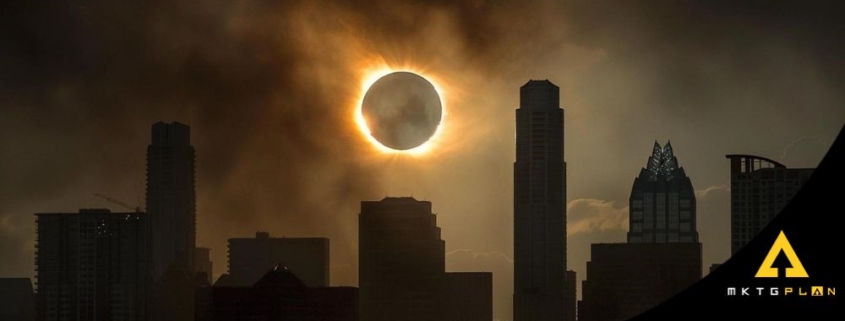Join the Journey with Eclipse Chasers Around the World
So, what was the result? Here are three accounts from our eclipse tracking team:
Photographer was initially swayed by promising weather forecasts to head to Austin. Upon arriving on Friday, his confidence in this choice began to wane.
“Day by day, the forecast for Central Texas deteriorated, predicting increasing cloudiness,” Lisota shared in his report. “Compelled by the gloomy forecast, we embarked on a last-minute drive from Austin to Arkansas early Sunday morning, ending up at Cossatot River State Park—a stunningly scenic locale blessed with a hopeful weather outlook.”
The day dawned with clear skies, but soon, lower clouds started to gather.

“As the eclipse began, we caught fleeting views of the partial phase through the clouds, which was cause for concern. However, roughly 15 minutes before totality, the clouds parted, unveiling the magnificent sight of a total solar eclipse,” recounted Lisota.
In the midst of the eclipse’s total phase, the need for solar filters vanished. “Though some thin, high clouds lingered, obscuring the sun slightly, the eclipse still managed to impress, highlighted by a distinctly luminous solar prominence visible to the naked eye,” Lisota expressed.
Above the Clouds and Grounded in Tradition
Journalist was soaring 35,000 feet above Buffalo, New York, at the eclipse’s climax, flying from Seattle to New York City.
From the left side of the plane, Schlosser experienced the sky’s transition to darkness for around four minutes starting at approximately 3:15 p.m. ET. Meanwhile, passengers seated on the right had a prime view of the sun.
The Delta flight’s captain cautioned everyone against directly gazing at the sun. Schlosser observed, “There was a notable absence of excitement among the passengers during the eclipse; many didn’t even bother to look up from their devices or pull up their window shades,” highlighting a subdued reaction to the celestial event.
Meanwhile, nestled in a yurt near Nashville, Indiana, paying $300 a night for the solitude and simplicity it offered, I found myself mulling over the enduring human fascination with solar eclipses.
Disconnected from the digital world, I lacked the constant weather updates I’d grown accustomed to, having diverted from a planned road trip to Texas in favor of a last-minute flight to the Midwest. My brothe hosted me in Cincinnati before we ventured to Indiana, where he had secured a hotel room months in advance, and I, a luxurious tent.
Armed with the precise time of the eclipse’s onset, 3:05 p.m. ET, unlike our ancestors, I lay in uncertainty about the weather conditions, the passing rain clouds during the night tempering my expectations.
Yet, as dawn broke, my concerns proved unfounded. The sky was graced only by thin, high clouds that did little to obscure the sun. My brothe and I, along with his partner Nancy, found ourselves setting up chairs near the Brown County Inn, immersed in the simple yet profound act of witnessing a celestial dance that has captivated humanity across the ages.
Adjacent to my humble setup, where I was mounting my modest Nikon camera onto a tripod, stood Steve Dubovich, meticulously fine-tuning his more formidable camera, equipped with a substantial lens. He shared with me that this journey, planned spontaneously just weeks prior with his wife, Deb, was anticipated as a “once-in-a-lifetime” adventure.
“I’m just hoping I nail the camera settings,” expressed Dubovich, a resident of Hebron, Indiana. “I’m experimenting with different configurations to capture that perfect halo effect during the total eclipse.”
Meanwhile, across the way, Jim Hutchinson, a retired astronomer from Atlanta, was engrossed in setting up a spotting scope for Nashville, Indiana’s Hoosier Fest attendees. He projected the evolving phases of the eclipse onto a cardboard screen using the compact telescope.
“This method is significantly safer,” he noted, explaining his approach.
Hutchinson’s commitment to eye safety stems from a personal backstory of losing sight in one eye due to an accident in his youth. “With only one eye, I’m not taking any risks with direct observation, even though the protective glasses are likely safe.”
Nearby, Sam Bracken was prepping his “Celtic Pig” food truck, anticipating a rush before the celestial event reached its zenith. He planned to step away at the crucial moment of totality at 3:05 p.m. to witness the eclipse firsthand. “I doubt anyone will be thinking about food once the eclipse begins,” he predicted, readying himself for a pause in business to observe the spectacle.
When asked about his primary anticipation for the day, Sam Bracken candidly admitted, “To be honest, it’s making money today. I wouldn’t have made the trip if there wasn’t a financial incentive involved.”
The crowd that had gathered for the eclipse wasn’t overwhelming, but as the sun morphed into a crescent and then narrowed to a bright sliver, excitement steadily built. With just two minutes to go, daylight swiftly dimmed to dusk. Suddenly, the sun vanished, stars twinkling against a darkened sky, turning murmurs of anticipation into cheers of awe—I joined in with my own voice raised in excitement.
For those in search of an impeccable photo of the total eclipse, it might be best to look elsewhere. Reflecting on the photographs I captured, I had to admit they fell short of expectations. Nonetheless, I chose to focus on the positive aspects of the experience, a sentiment echoed by Steve Dubovich.
“I’m actually quite pleased,” Dubovich shared with me afterward. “Considering all the potential for cloud cover and other obstacles, we were quite fortunate.”


